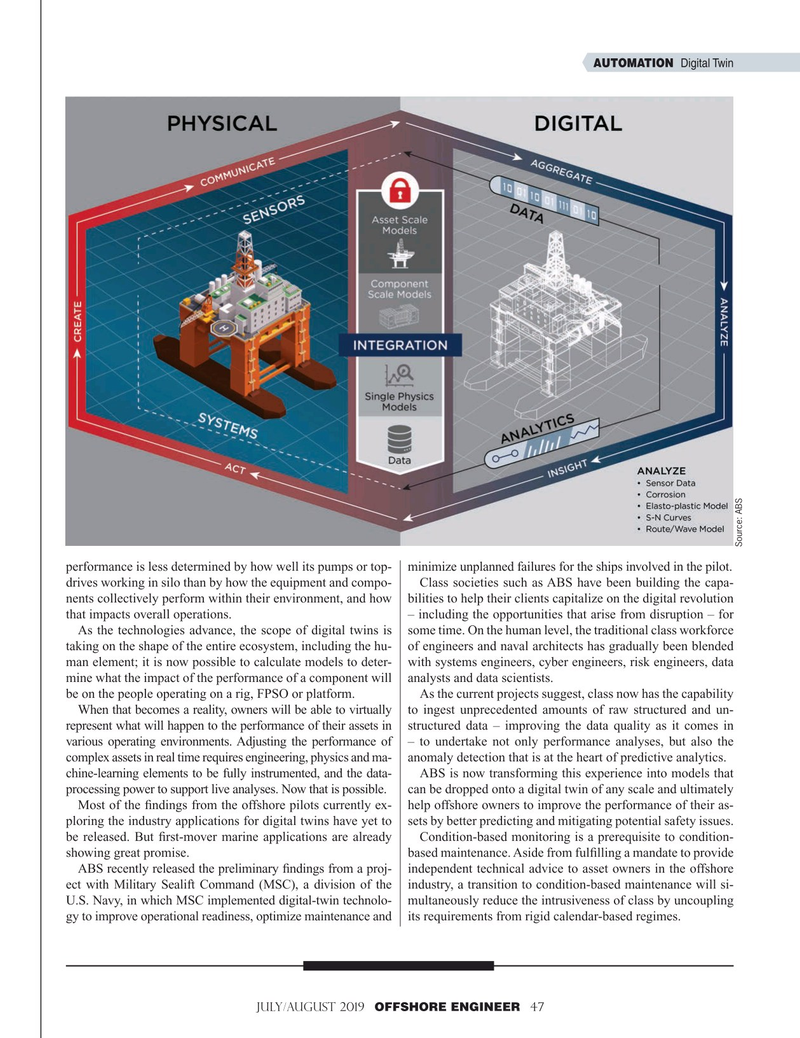
Page 47: of Offshore Engineer Magazine (Jul/Aug 2019)
Subsea Processing
Read this page in Pdf, Flash or Html5 edition of Jul/Aug 2019 Offshore Engineer Magazine
AUTOMATION Digital Twin
Source: ABS performance is less determined by how well its pumps or top- minimize unplanned failures for the ships involved in the pilot.
drives working in silo than by how the equipment and compo- Class societies such as ABS have been building the capa- nents collectively perform within their environment, and how bilities to help their clients capitalize on the digital revolution that impacts overall operations. – including the opportunities that arise from disruption – for
As the technologies advance, the scope of digital twins is some time. On the human level, the traditional class workforce taking on the shape of the entire ecosystem, including the hu- of engineers and naval architects has gradually been blended man element; it is now possible to calculate models to deter- with systems engineers, cyber engineers, risk engineers, data mine what the impact of the performance of a component will analysts and data scientists.
be on the people operating on a rig, FPSO or platform. As the current projects suggest, class now has the capability
When that becomes a reality, owners will be able to virtually to ingest unprecedented amounts of raw structured and un- represent what will happen to the performance of their assets in structured data – improving the data quality as it comes in various operating environments. Adjusting the performance of – to undertake not only performance analyses, but also the complex assets in real time requires engineering, physics and ma- anomaly detection that is at the heart of predictive analytics.
chine-learning elements to be fully instrumented, and the data- ABS is now transforming this experience into models that processing power to support live analyses. Now that is possible. can be dropped onto a digital twin of any scale and ultimately
Most of the ? ndings from the offshore pilots currently ex- help offshore owners to improve the performance of their as- ploring the industry applications for digital twins have yet to sets by better predicting and mitigating potential safety issues.
be released. But ? rst-mover marine applications are already Condition-based monitoring is a prerequisite to condition- showing great promise. based maintenance. Aside from ful? lling a mandate to provide
ABS recently released the preliminary ? ndings from a proj- independent technical advice to asset owners in the offshore ect with Military Sealift Command (MSC), a division of the industry, a transition to condition-based maintenance will si-
U.S. Navy, in which MSC implemented digital-twin technolo- multaneously reduce the intrusiveness of class by uncoupling gy to improve operational readiness, optimize maintenance and its requirements from rigid calendar-based regimes.
JULY/AUGUST 2019 OFFSHORE ENGINEER 47

 46
46

 48
48